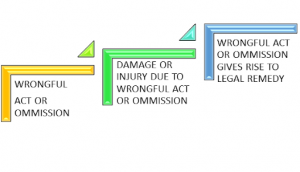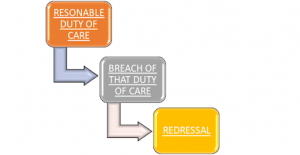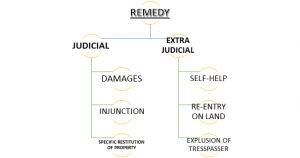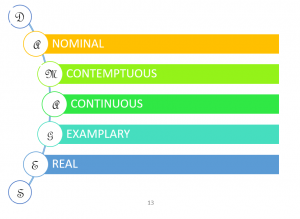This article is written by Ashpreet Kaur, IInd year student, B.B.A. LL.B, Symbiosis Law School, NOIDA. In this article, the author discusses about the nature and elements of the law of torts in detail along with some important case analysis.
Introduction
Before the state has emerged, the law was enforced by a person whose right has been violated with the assistance of family and clans. Sir Henry Maine remarked this as the penal law of ancient communities is not a law of crimes It is the law of wrongs in the modern world and is known as the law of torts. Under Indian constitution article 372, a base for the common law of torts in India is provided.
A tort is a civil wrong which arises when a person breaches the duty he owed to another person. A legal right is a right which is given to an individual whereas legal duty is when the same individual violates another person’s legal rights, thereby causing damage which asks for compensation (Remedy) which is unliquidated.
On reviewing the definition of torts one can see it is a combination of three differently essentials which can be classified as-
A tort is a civil wrong for which the legal remedy is an action brought by means of civil proceedings by or on behalf of the injured party for damages or some other legal remedy desired by the person who has suffered the wrong
A tort is a civil wrong
The first and the most important feature of tort is that it is a civil action and not a criminal act. It is considered as a wrong against a particular person, not the society as a whole. It infringes the right of a person or a group of person but in a criminal action, the crime is committed against the society as a whole. Unlike criminal cases, in civil wrong, it depends on the choice of a claimant that he wants proceedings or not there is no compulsion. Civil wrong does not carry the same amount of seriousness as that of a criminal act. The legal remedy is an action brought by means of a civil proceeding.
Once it is identified that action done is a civil wrong, the next step is to bring an action under civil proceedings for the sake of legal remedies. One who proceeds with a civil suit is a claimant demanding for enforcement of his rights. In these proceedings, the sole purpose is to safeguard the rights of claimant, unlike criminal proceedings where the sole purpose is to punish the culprit. Civil proceedings are mainly held to figure out the severity of wrong and what can be done in order to bring the claimant in the same situation as he/she was before the wrong was committed. In these cases, no punishment like jail or rehabilitation centre is given only damages or other remedies are given for compensating.
Constituents of torts
The term law of torts can be defined as an instrument to respect the interests and rights of others and adhere to a standard of reasonable behaviour. A protected interest procreates a legal right, which in turn procreates a corresponding legal duty. An act which violates legal right is termed as wrongful act on the behalf of which compensation for the losses can be recovered from the person who has violated the right. On the contrary, not every wrongful act is considered as torts. In order to constitute a tort there should be-

- A wrongful act or omission.
- Wrongful act or omission should give rise to the damage or injury.
- Wrongful act must be of such a nature that it gives rise to legal remedy in order to compensate for losses.
1. A wrongful act or omission
The first and foremost thing required for constituting a tort is wrongful act or omission of the act either done negligently or intentionally that was needed to be done. The act accompanied by should, under the situation, be legally wrong and must prejudicially affect the other party. The duty must be fixed by laws. These legal rights are divided into two parts-
1. Private rights
These rights belong to a person individually rather than the world at large which includes rights related to body, mind, estate here means property. Rights such as a right of property, right of reputation, right of bodily safety etc are considered as private rights.
2. Public rights
These rights are common to all the citizens of a state but are vested and vindicated by political entities. Citizens cannot enforce these rights but can exercise them. Using rivers, roads, natural resources, parks etc comes under public property and using them is considered as a public right. Its remedy lies in the indictment.
2. Damages arising out of wrongful act or omission
The term damages should not be considered as the plural of damage under the law of torts. The sum of money awarded by the court to compensate for the Damage is called Damages. In general, torts consist of an act done by a person who causes injury to another for which damages are claimed by the latter against the former. Injury is strictly limited to an actionable wrong whereas damages depict loss or harm that occurs which may be actionable. The following maxims show the importance of legal damages-
1. Injuria sine damno
In this maxim, Injuria means injury to a legal right, a tortious act which can also be accidentally done. Sino means without and word Damno depicts damages in terms of money, loss of comfort, health etc. Overall this maxim means that infringement of an absolute private right without any damage whereas this is actionable per se. Some of the cases under this maxim are Ashby v. White case where a voter was refused to cast his valid vote, later on, he was compensated in terms of money even though the party to whom he wants to vote ultimately won the election.
2. Damno sine injuria
This maxim is contradictory to the above maxim and states that actual damage or loss that has taken place without any infringement of legal right is not actionable per se. In Gloucester Grammar School Case, the defendant has set up a school opposite to that of plaintiff’s consequently the plaintiff was required to lower the tuition fee in competition here no compensation will provide even though the plaintiff has suffered loss.
3. Remedy
The wrongful act or omission committed must come under the ambit of wrongs for which the remedy is civil action for damages. Basically, it is the right to damages that brings such acts under the ambit of the law of torts. Damages claimed under the torts are unliquidated ones. We will study remedy in details in the further.
Tortious liability
In tortious liability, there must be a duty of care towards the persons generally as fixed by laws and breach of that duty results in actionable unliquidated damages. Nowadays more people suffer from damages arising from a careless act or intentional wrongdoings. The tortious liability is further a three-step process –
1. There must be a reasonable duty of care.
2. There should be a breach of duty of care.
3. Redressal by an act of unliquidated damages.

1. Reasonable duty of care
The duty of care renders moral as well as legal obligation to ensure the safety of people in our surroundings or our immediate neighbours by adherence to standard reasonable care and avoiding any harm that is foreseeable. Elements in the duty of care are as follows-
Caprio Test
A. Reasonable foreseeable- It is to test that, if a reasonable person is swapped with the defendant could reasonably foresee the situation. This issue ensures possibilities instead of probabilities.
B. Proximity- it is used in measuring the sense of closeness or neighbourhood. This relationship occurs between the wrongdoer and the person who has suffered damage and there should be a prior factual link between the parties.
C. Just, fair and reasonable link- it is to check whether it is fair and just to apply the duty of care on the wrongdoer. These conditions can also be applied on the ground of imposition of a duty of care.
2. Breach of duty of care
When a person fails to match with the standard of duty laid down by laws and he is negligently performing his acts is liable for a personal injury case in the law of torts in order to determine a breach of duty one has to examine on the following basis-
A. The foreseeability of harm to the claimant should not be taken.
B. An adequate standard of care owed by the defendant to the claimant.
C. Comparison of conduct of the defendant with the expected standard of care.
3. Redressal by an act of unliquidated damages
The injured party in the case of the law of torts is treated under unliquidated damages. It is the amount that one cannot assume as it is not fixed it varies according to the situation. These are of two types general and special damages.
Ubi Jus Ibi Remedium
This maxim denotes that where there is a right there is a remedy. This means that if a man has right he must maintain it and if he is injured in the enjoyment of that right he can also seek redressal. It is to note that moral and political wrong are not included in it. There is no remedy for breach of promise without consideration or oppressive legislation. This principle has been laid down in Ashby V. White case. There are two types of remedies –
1. Judicial remedies- These types of remedies are brought by the claimant in the court of law usually in civil law jurisdiction. The person against whom the tort is committed can take recourse to law and seek his redressal.
2. Extra judicial remedies- These remedies are available outside the legal system . Restoration of these kinds of remedies depends upon a person’s willingness and strength by the way of self-help. In such cases instead of visiting court, the person protects his rights himself. Nevertheless, the law imposes a restriction on the usage of such rights as the force used should be reasonable and necessary in given circumstances.

Difference between judicial and extra-judicial remedies
|
Judicial Remedy |
Extra-Judicial Remedy |
|
They require the process of law. |
They do not require the process of law. |
|
No use of force at all. |
Use of reasonable force. |
|
Some delay is caused due to procedures of the court. |
Immediate relief is available. |
|
Compensation and other relief is available in most cases. |
Compensation will not be available in most remedies. |
|
Types of judicial remedy- 1) Damages 2) Injunction 3) Specific restitution of property |
Types of extrajudicial remedy- 1) Self-help. 2) Re-entry on land. 3) Expulsion of the trespasser. |
Types of judicial and extra-judicial remedies
Judicial remedies
1- Damages- In this suit for damages the courts grant monetary compensation to the plaintiff for damage suffered by him due to the defendant. Damages are granted once for all, the plaintiff can not approach the court for the second action for the same case simply because his injury proved to more serious as thought before. If more than one right is violated they all need to be address in the same case, no two cases should be filed for the same facts.
2- Injunction- It is an order passed by the court to restrict the continuance of wrongful act or omission. With the change of the time, all courts can issue this order as per just and fair conditions applicable in the particular case. It is taken against trespass, passing off, nuisance etc. It can be demanded as right it depends on the discretion of the court. The court has the power to grant a mandatory injunction where the defendant is ordered to take positive actions in order to rectify his mistake.
3- Specific restitution of property- This concept revolves around receiving the benefit which is unjust. A person who has wrongfully dispossessed any moveable or immovable property is entitled to recover the same.. In the case of State Of Gujarat V. Essar Oil Limited has explicated the phrase benefit which means that any kind of unjust advantage either received or conferred.
Extra-judicial remedies
1- Self-help- It has been regarded as an individual implementing their rights without visiting higher authorities. But this kind of remedy cannot be regulated freely our legal system places different degrees of limitations on such self-help and law vary according to place. People opt for when feeling that they have no legal remedy left or courts are biased.
2- Re-entry on land– In this part, if a person is wrongfully and forcefully dispossessed of his land may take possession of the same by any means may be peacefully or forcefully. He will not be liable for trespass. But the force used should be reasonable and its consequences should be foreseeable. As long as civil rights are concerned possession of rightful owner gained by forced entry is lawful among the parties.
3- Expulsion of a trespasser- The legal and rightful owner of a premise is entitled to drive out the trespasser as long as he does him no injury the owner must not resort to violence. He is entitled to use force but that force must not convert into violence.
Damages and its types
Damages is a first and foremost remedy in torts. They are not only confined to the loss which the plaintiff has suffered but also the satisfaction of the plaintiff accompanied by punishment for the wrongdoer to teach him a lesson. Damages are provided only when there are direct consequences of the wrongdoer act. The following test decides the quantum of damages be provided-
Causation- Whether the damage caused was raised by the wrongful act this question is decided by “but for” test. In it but for the defendant’s actions would the claimant has suffered the loss? If the answer to this question is yes then the defendant is not liable and if the answer is yes the defendant is liable. It is a causal relationship between conduct and result
Foreseeability- It would be unjust to a person if he/she is held liable for all the consequences of his act which includes unforeseeable events also, consequently the result would be endless. To overcome this issue, directness is the perfect test, in it we test the foreseeability and direct consequences of the act ignoring the indirect ones. The act done must be in the ambit of a common man to think its consequence.

Types of damages
a) Contemptuous damages- These types of damages are given in trifling matters where court think that such matter should not be brought before courts. In such cases court forms a low opinion of the plaintiff’s claim and award not more than a negligible amount of money such as court had awarded 1 rupee or even one and half of a rupee in some cases.
b) Nominal damages- These types of damages are granted for the sake of recognition of legal right which is violated rather than compensation. These are actionable per se, for example, Ashby V. White And Constantine V. Imperial Hotels Ltd.
c) Real damages- This kind of damages are granted in those cases where real damages are incurred that needed to be compensated by the defendant. The main purpose is to make the plaintiff in the same position as he was before the damage has incurred.
d) Exemplary damages- When a tort is committed intentionally, compensation paid for same is not real damages but the amount higher than the actual damages in order to ensure that no one again commits the same crime again it is example setter for others. It is treated as a punishment rather than compensation. Like in Rookes V. Barnard case in which they restated the exemplary damages law.
e) Continuous damages- In its consequences of the act committed stays for a longer period of time, but have not materialized till the decision of the case. In Subhas Chandra V. Ram Singh case in which a seven-year-old boy lost his legs and was incapable of doing certain acts, Delhi HC awarded rs.75000 as damages.
Analysing the important cases in the law of torts
Facts- The plaintiffs were tenants of the land on which they work a mine. Their working extended through underground shafts to an area below neighbouring land. The defendants were neighbouring mill owners and they have constructed a reservoir for mill operations. The reservoir was not strong enough to bear the pressure of water consequently it burst downwards and flooded the plaintiff’s mineshaft.
Judgement- According to BLACKBURN, J in his words – the rule of law is that person who, for his own purpose brings on his land and keeps there anything likely to do mischief if escapes must keep it in his peril and is prima facie liable for all the damages for its escape. In this case, a dangerous thing in premise escapes and the defendant is liable for punitive
Mukesh Textile Mills v. Subramanya Sastry
Facts- A was the owner of a sugar factory. B owned land adjacent to A’s sugar factory. A stored quantity of molasses and it escaped to B’s land and damaged B’s crops. B sued A.
Judgement- Collection of molasses in large quantities are considered to be non-natural use of land and its escape can make a person liable.
State Bank of India v. Shyama Devi
Facts- The claimant i.e Smt. Shyama Devi filed a suit against the State Bank of India in Tribunal and High court asking for the refund of money which she asked the company’s employee in to deposit in her account. The Tribunal asked the bank to pay Rs 10,040 whereas the latter asked to pay Rs 14,145.
Judgement- The decision was made in favour of the Appellant by the Supreme Court. Dealing with the first issue if Mr Shukla was in the course of employment court concluded that he was not in course of employment it was by the respondent that he was chosen as a mediator. The Supreme Court hence dismissed the plaintiff’s claim with regard to Rs 11,000 (4,000 plus 7,000) and interest thereon. The decretal amount granted by the High Court shall be reduced by Rs 11,000 and interests thereon. No order as to costs.
Ushaben v. Bhagyalaxmi Chitra Mandir
Facts- The plaintiff contended that the film “Jai Santoshi Maa” hurt the religious feelings of the plaintiff in so far as Goddesses Saraswati, Laxmi, and Parvati was depicted as jealous and was ridiculed and thus sued for a permanent injunction against the defendants to restrain them from exhibiting the film.
Judgement- It was observed that hurt religious feelings had not been recognized as a legal wrong. Moreover, no person has a legal right to enforce his religious views on another or to restrain another from doing a lawful act, merely because it did not fit in with the tenets of his particular religion.
Bhim Singh v. State of J. & K.
The petitioner, an M.L.A. of Jammu & Kashmir, was wrongfully detained by the police while he was going to attend the Assembly session. Further, he was not produced before the Magistrate within the requisite period. As a consequence of this, he was deprived of his constitutional right to attend the Assembly session. There was also a violation of the fundamental right to personal liberty guaranteed under Article 21 of the Constitution.
By the time the petition was decided by the Supreme Court, Bhim Singh had been released, but by way of consequential relief, exemplary damages amounting to Rs. 50,000 were awarded to him.
Conclusion
On the concluding note, I would like to sum up that there are still many issues that are unattended and we will land up in dilemma if we try to solve them without any laws or precedents. Damages mainly depend upon the economic status of a country and mindset of society as till some extent thinking of the judges are affected what society thinks in cases related to civil laws. Damages show an easy way to get away with the mistakes committed by rich brats it is easy for them to pay monetary compensation for their mistakes in place of punishment it does give them a chance to realise their mistakes. In India, rules for the purpose of damages are not fully utilized as people are not commonly aware of it. Due to the remoteness of applicability, it is not well-developed law in India.
Torts arise from the negligent acts and lack burden of proof in some instances plaintiff may prevail in a tort case despite the fact that person who has caused harm is acquitted in a criminal case this can lead us to the principle of double jeopardy. There are also some loopholes in judicial and extra-judicial remedies as in judicial remedy we can measure the term reasonable foreseeability and compensation provided in monetary is sufficient or not and in extra-judicial remedies exceeding the reasonability in once right can show him the way to jail and it can be a measure that how much is too much. These are some issues which still need to be addressed in the law of torts.
Bibliography
1-DHIRAJLAL, R. A. (1987). THE LAW OF TORTS (27 ed.). (J. G. SINGH, Ed.) LEXISNEXIS. Retrieved AUGUST 2017, from WWW.LEXISNEXIS.CO.IN
2-GOUDKAMP, W. P. (2015). WINFIELD AND JOLOWICZ ON TORTS (18 ed.). THOMSON REUTERS. Retrieved AUGUST 2017
3-HEDLEY, S. (2016). TORT (7 ed.). OXFORD. Retrieved AUGUST 2017
4-PANDEY, J. N. (2016). LAW OF TORTS WITH CONSUMER PROTECTION ACT AND MOTOR VEHICLE ACT. CENTRAL LAW PUBLICATION. Retrieved AUGUST 2017
5-SINGH, j. G. (2010). THE LAW OF TORTS (26 ed.). LEXISNEXIS.
6-STEELE, J. (2017). TORT LAW (3 ed.). OXFORD. Retrieved AUGUST 2017
7-WITTING, J. M. (2016). STREET ON TORTS (13 ed.). OXFORD. Retrieved AUGUST 2017












